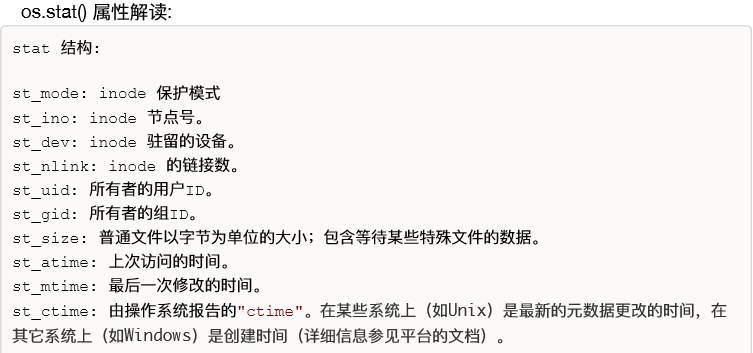day021 模組(collections,time,random,os,sys)
關於模組
import
from xxx import xxx
2. Collections
1. Counter 計數器
2. 棧: 先進後出.
佇列:先進先出
deque:雙向佇列
3. defaultdict 預設值字典
4. namedtuple 命名元祖. struct_time 結構化時間就是命名元祖
5. OrederedDict 有序字典。 按照我們儲存的順序儲存. 和3.6以後的字典一樣的
3. time 時間模組
1. 獲取系統時間 time.time() 時間戳
2. 格式化時間 strftime() 時間格式: %Y-%m-%d %H:%M:%S %Y-%m-%d
3. 結構化時間 time.gmtime() time.localtime()
strptime() 把格式化時間轉化成結構化時間
mktime() 把結構化時間轉化成時間戳
4. os和sys
os.sep 檔案路徑分隔符
sys.path python查詢模組的路徑
一 、collections
1. Counter 計數
lst=["a","a","b","g"]
ret=Counter(lst) #lst中的元素必須為可雜湊,不然會報錯
print(dict(ret)) #可將其轉換成字典的形式 #{'a': 2, 'b': 1, 'g': 1}.

from collections import Counter # #Counter 計數 s="sdffgds sdggdggdgerhumu34$3*7Counter" q=Counter(s) for i in q: print(i,q[i]) dic={} for i in s: dic[i]=dic.setdefault(i,0)+1 #用字典value 計數 ,setdefault 存在就不做任何操作 print(dic) # li2=["a","a","b","g"] # ret=Counter(li2) # print(ret) lst=["a","a","b","g"] ret=Counter(lst) #lst中的元素必須為可雜湊,不然會報錯 print(dict(ret)) #可將其轉換成字典的形式 #{'a': 2, 'b': 1, 'g': 1}
2.defaultdict 預設值字典

from collections import defaultdict # lst=[11,32,22,45,66,77,78] # d=defaultdict(list) #d=defaultdict(可呼叫的物件或可執行物件) # for el in lst: # if el>66: # d["key1"].append(el) #如果key1不存在時,就會去執行list(),所以d["key1"]=[] # else: # d["key2"].append(el) # print(d) #defaultdict(<class 'list'>, {'key2': [11, 32, 22, 45, 66], 'key1': [77, 78]}) # print(dict(d)) #將其變成字典 def func(): return "胡辣湯" d=defaultdict(func) print(d["a"]) # 胡辣湯 相當d["a"]=func() print(d["b"]) # 胡辣湯 相當d["a"]=func() print(dict(d)) #{'a': '胡辣湯', 'b': '胡辣湯'}defaultdict
3.佇列 queue
#佇列 import queue # q = queue.Queue() # 建立佇列 q.put("李嘉誠") q.put("陳冠希") q.put("周潤發") q.put("吳彥祖") print(q.get()) print(q.get()) print(q.get()) print(q.get()) # print(q.get()) # 佇列中如果沒有元素了. 繼續獲取的話. 會阻塞 print("拿完了")
4.雙向佇列
from collections import deque q = deque() # 建立一個雙向佇列 q.append("高圓圓") q.append("江疏影") q.appendleft("趙又廷") q.appendleft("劉大哥") # 劉大哥 趙又廷 高圓圓 江疏影 print(q.pop()) # 從右邊獲取資料 print(q.pop()) print(q.popleft()) # 從左邊獲取資料 print(q.popleft()) print(q.pop())
5.命名元組namedtuple
from collections import namedtuple # point=namedtuple("Point",["x","y"]) #命名元組 相對於寫了一個類 可用於 寫選單 # p=point(2,5) # print(p.x) # print(p.y) person=namedtuple("Person","name age") # p=person(name="deng",age=12) p=person("deng",123) print(p.name) print(p.age)
6.orderdict
from collections import OrderedDict # 按照我們儲存的順序儲存資料 od = OrderedDict({ 'b':'薯條','a':'娃哈哈', 'c':'胡辣湯'}) print(od) dic = {} # print(dic["周潤發"]) # 報錯 print(dic.get("周潤發", "英雄本色")) # None
二.time模組
1.獲取當前系統時間, 時間戳 t=time.time()
2. 獲取格式化時間 t= time.strftime("%Y-%m-%d %H:%M:%S")
3.獲取結構化時間 t = time.localtime()
格式化時間 -> 時間戳

import time #獲取系統時間 時間戳 time.time() print(time.time()) #格式化時間 strftime string format time time.strftime(格式) t=time.strftime("%Y-%m-%d %H:%M:%S") print(t) # count=0 # while 1: # t2=time.strftime("%S") # time.sleep(1) # count+=1 # print(t2) #結構化時間 time.localtime() t=time.localtime(1888888000) #時間戳---》轉化成結構化時間 t2=time.gmtime(0) #格林尼治時間 print(t2) print(t)#tm_year=2029, tm_mon=11, tm_mday=9, tm_hour=11, tm_min=6, tm_sec=40, tm_wday=4, tm_yday=313, tm_isdst=0 print(t.tm_year) print(t.tm_mon) print(t.tm_mday) print(t.tm_min) print(t.tm_sec) print(t.tm_wday) print(t.tm_yday) str_time=time.strftime("%Y-%m-%d %H:%M:%S",t) #將結構化時間轉化成格式化時間,此處的t必須為結構化時間 print(str_time) #格式化時間轉化成結構化時間 strptime string parse time time.strptime(格式化時間,格式化的方式) s="2018-12-11 8:30:43" tt=time.strptime(s,"%Y-%m-%d %H:%M:%S") print(tt) # #結構化時間轉化成時間戳 time.mktime(結構化時間) ss=time.mktime(tt) print(ss)time模組

import time #小時 分鐘 t1="2018-10-11 11:12:33" t2="2020-12-19 8:12:34" #格式化時間--》結構化時間 struct_time1=time.strptime(t1,"%Y-%m-%d %H:%M:%S") # print(struct_time1) struct_time2=time.strptime(t2,"%Y-%m-%d %H:%M:%S") #結構化時間---》時間戳 t11=time.mktime(struct_time1) # print(t11) t12=time.mktime(struct_time2) # 時間差: t=t12-t11 # 60 60 # print(t) h=t//(60*60) m=(t-h*3600)//60 s=t%60 print(h) print(m) print(s) print("t2和t1的時間差為:%s小時,%s分,%s秒"%(h,m,s)) def time_than(t1,t2): ''' 計算時間差的函式 :param t1: 為格式化時間點1 "%Y-%m-%d %H:%M:%S" :param t2: 為格式化時間點2 "%Y-%m-%d %H:%M:%S" :return: 以字典形式返回時間差 ''' #格式化時間-->結構化時間 struct_time1 = time.strptime(t1, "%Y-%m-%d %H:%M:%S") struct_time2 = time.strptime(t2, "%Y-%m-%d %H:%M:%S") #結構化時間--->時間戳 t11 = time.mktime(struct_time1) t12 = time.mktime(struct_time2) t=t12-t11 day=t//(3600*24) h=(t-day*3600*24)//3600 min=(t-day*3600*24-3600*h)//60 s = t % 60 return {"day":day,"h":h,"m":m,"s":s} print(time_than(t1,t2))時間差

import time begin = "2019-11-14 16:30:00" end = "2018-11-14 18:00:00" # 用時間戳計算出時間差(秒) begin_struct_time = time.strptime(begin, "%Y-%m-%d %H:%M:%S") end_stract_time = time.strptime(end, "%Y-%m-%d %H:%M:%S") begin_second = time.mktime(begin_struct_time) end_second = time.mktime(end_stract_time) # 秒級的時間差 180000 diff_time_sec = abs(begin_second - end_second) # 轉化成結構化時間 t = time.gmtime(diff_time_sec) # 最好用格林尼治時間。 否則有時差 print(t) print("時間差是%s年%s月 %s天 %s小時%s分鐘" % (t.tm_year-1970, t.tm_mon-1, t.tm_mday-1,t.tm_hour, t.tm_min ))時間差二
三. random模組
import random print(random.random()) #產生0-1的隨機小數 print(random.randint(1,9)) #產生一個 1-9 包括1和9 的整數 print(random.randrange(1,9)) ##產生一個 1-9 不包括1和9 的整數 print(random.randrange(1,9,2)) #產生1個 [1,3,5,7] lst=["a","b",[1,2,"a"],"g"] print(random.choice(lst)) #從列表lst中隨機取一個元素 print(random.sample(lst,2)) #從列表lst中隨機取2個元素 random.shuffle(lst) #打亂順序 print(lst)
四 OS模組
os.makedirs('dirname1/dirname2') 可⽣生成多層遞迴目錄
os.removedirs('dirname1') 若目錄為空,則刪除,並遞迴到上一級目錄,如若也為空,則刪 除,依此類推
os.mkdir('dirname') 生成單級目錄;相當於shell中mkdir dirname
os.rmdir('dirname') 刪除單級空目錄,若目錄不為空則無法刪除,報錯;相當於shell中 rmdir (dirname)
os.listdir('dirname') 列出指定目錄下的所有檔案和子目錄,包括隱藏檔案,並以列表方式 列印
os.remove() 刪除一個檔案
os.rename("oldname","newname") 重新命名檔案/目錄
os.stat('path/filename') 獲取檔案/目錄資訊
os.system("bash command") 運⾏shell命令,直接顯示
os.popen("bash command").read() 運行shell命令,獲取執⾏行行結果
os.getcwd() 獲取當前工作目錄,即當前python指令碼工作的目錄路徑
os.chdir("dirname") 改變當前指令碼工作目錄;相當於shell下cd
os.path.abspath(path) 返回path規範化的絕對路路徑
os.path.split(path) 將path分割成目錄和⽂檔名二元組返回
os.path.dirname(path) 返回path的目錄。其實就是os.path.split(path)的第一個元素
os.path.basename(path) 返回path最後的檔名。如果path以/或\結尾,那麼就會返回空值。 即os.path.split(path)的第二個元素
os.path.exists(path) 如果path存在,返回True;如果path不存在,返回False
os.path.isabs(path) 如果path是絕對路徑,返回True os.path.isfile(path) 如果path是⼀一個存在的⽂檔案,返回True。否則返回False
os.path.isdir(path) 如果path是⼀一個存在的目錄,則返回True。否則返回False
os.path.join(path1[, path2[, ...]]) 將多個路徑組合後返回,第⼀一個絕對路徑之前的引數 將被忽略
os.path.getatime(path) 返回path所指向的檔案或者目錄的最後訪問時間
os.path.getmtime(path) 返回path所指向的檔案或者目錄的最後修改時間
os.path.getsize(path) 返回path的大小
#特殊屬性: os.sep 輸出作業系統特定的路徑分隔符,win下為"\\",Linux下為"/"
os.linesep 輸出當前平臺使用的行終止符,win下為"\r\n",Linux下為"\n"
os.pathsep 輸出⽤用於分割檔案路徑的字元串 win下為;, Linux下為:
os.name 輸出字串串指示當前使⽤用平臺。win->'nt'; Linux->'posix'

五.SYS 模組
所有和python直譯器相關的都在sys模組. sys.argv
命令行引數List,第⼀一個元素是程式本身路路徑 sys.exit(n)
退出程式,正常 退出時 exit(0), 錯誤 退出sys.exit(1)
sys.version 獲取Python解釋程式的版本資訊
sys.path 返回模組的搜尋路徑,初始化時使⽤用PYTHONPATH環境變數量的值
sys.platform 返回作業系統平臺名稱

